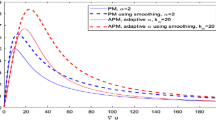Abstract
We develop a novel time-selection strategy for iterative image restoration techniques: the stopping time is chosen so that the correlation of signal and noise in the filtered image is minimized. The new method is applicable to any images where the noise to be removed is uncorrelated with the signal, under the assumptions that the filter used is suitable for the given type of data, and that neither the additive noise nor the filtering procedure alter the average gray value; no other knowledge (e.g. the noise variance, training data etc.) is needed.
We analyse the theoretical properties of the method, then test the performance of our time estimation procedure experimentally, and demonstrate that it yields near-optimal results for a wide range of noise levels and for various filtering methods.
Similar content being viewed by others
Explore related subjects
Discover the latest articles, news and stories from top researchers in related subjects.References
Bertero, M. and Boccacci, P. 1998. Introduction to Inverse Problems in Imaging. Institute of Physics Publishing, Bristol, UK.
Black, M.J., Sapiro, G., Marimont, D., and Heeger, D. 1998. Robust anisotropic diffusion. IEEE Transactions on Image Processing, 7(3):421–432.
Capuzzo Dolcetta, I. and Ferretti, R. 2001. Optimal stopping time formulation of adaptive image filtering. Applied Mathematics and Optimization, 43:245–258.
Catté, F., Lions, P.-L., Morel, J.-M., and Coll, T. 1992. Image selective smoothing and edge-detection by nonlinear diffusion. SIAM Journal on Numerical Analysis, 29(1):182–193.
Iijima, T. 1962. Basic theory on normalization of a pattern. Bulletin of Electrical Laboratory, 26:368–388 (in Japanese).
Mrázek, P. 2001. Nonlinear diffusion for image filtering and monotonicity enhancement. Ph.D. Thesis, Center for Machine Perception, Department of Cybernetics, Faculty of Electrical Engineering, Czech Technical University, Prague, Czech Republic. Available at ftp://cmp.felk.cvut.cz/pub/cmp/articles/ mrazek/Mrazek-phd01.pdf.
Mrázek, P. 2002a. Decorrelation criterion to select diffusion stopping time: Experimental evaluation. Research Report K333-13/02, CTU-CMP-2002-01, Department of Cybernetics, Faculty of Electrical Engineering, Czech Technical University, Prague, Czech Republic.Available at ftp://cmp.felk.cvut.cz/pub/ cmp/articles/mrazek/Mrazek-TR-2002-01.pdf.
Mráazek, P. 2002b. Monotonicity enhancing nonlinear diffusion. Journal of Visual Communication and Image Representation, 13(1/2):313–323.
Papoulis, A. 1990. Probability and Statistics. Prentice-Hall: Englewood Cliffs, NJ.
Perona, P. and Malik, J. 1990. Scale-space and edge-detection using anisotropic diffusion. IEEE Transactions on Pattern Analysis and Machine Intelligence, 12(7):629–639.
Rudin, L.I., Osher, S., and Fatemi, E. 1992. Nonlinear total variation based noise removal algorithms. Physica D, 60:259–268.
Sporring, J. and Weickert, J. 1999. Information measures in scalespaces. IEEE Transactions on Information Theory, 45:1051–1058.
Weickert, J. 1996. Theoretical foundations of anisotropic diffusion in image processing. Computing (Suppl. 11), pp. 221–236.
Weickert, J. 1998. Anisotropic Diffusion in Image Processing. European Consortium for Mathematics in Industry (B.G. Teubner, Stuttgart).
Weickert, J. 1999. Coherence-enhancing diffusion of colour images. Image and Vision Computing, 17:201–212.
Witkin, A.P. 1983. Scale space filtering. In Proceedings of the 8th International Joint Conference on Artificial Intelligence,A. Bundy (Ed.), Karlsruhe, Germany. William Kaufmann, pp. 1019–1023.
Author information
Authors and Affiliations
Rights and permissions
About this article
Cite this article
Mrázek, P., Navara, M. Selection of Optimal Stopping Time for Nonlinear Diffusion Filtering. International Journal of Computer Vision 52, 189–203 (2003). https://doi.org/10.1023/A:1022908225256
Issue Date:
DOI: https://doi.org/10.1023/A:1022908225256




